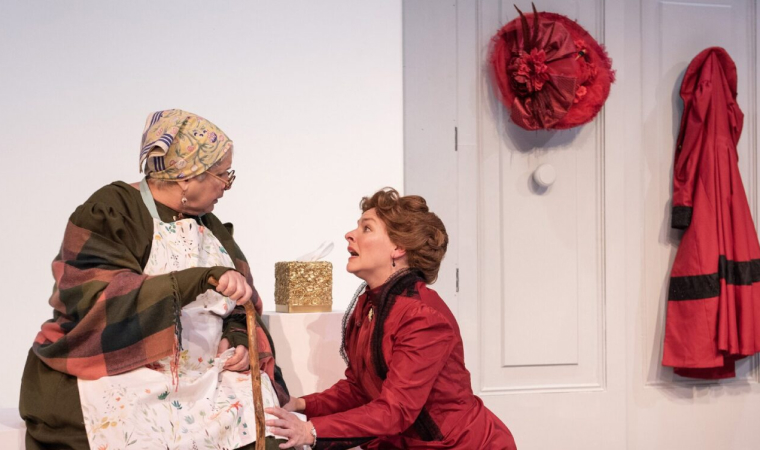
Nora Helmer (Rachel Burttram) begs her family's nanny, Anne Marie (Elizabeth Dimon) for help in GableStage's production of "A Doll's House, Part 2." (Photo by Magnus Stark)
Literally, with the snap of a finger, the lights change in GableStage’s impressive production of Lucas Hnath’s funny, absorbing, and incisive play, “A Doll’s House, Part 2.”
With the lighting change, the production whisks us from 1894 Norway to 2023 Coral Gables. And back again.
In fact, a tug-of-war of sorts plays out in GableStage’s production as we travel back and forth in time. This may symbolize the ongoing struggle for women’s rights and equality. Indeed, society often makes progress in the battle for these hard-fought rights, only to regress.
In GableStage’s production, which runs through Sunday, March 19 (streaming is also available), the actors dance and jerk at times in a modern style to a loud beat. Perhaps such moves symbolize a celebration of society’s advancement in the areas of women’s rights and equality. But those moves may also serve as expressions of each character’s individuality.
Chances are you are familiar with the characters. They include Nora and Torvald Helmer from the late, great Norwegian playwright Henrik Ibsen’s 1879 masterpiece, “A Doll’s House.” Ibsen, widely known as “the father of modern drama,” wrote “A Doll’s House,” a pioneer of modern theater, as an insightful commentary on the societal norms of 19th-century Norway and the role of women in marriage and society.
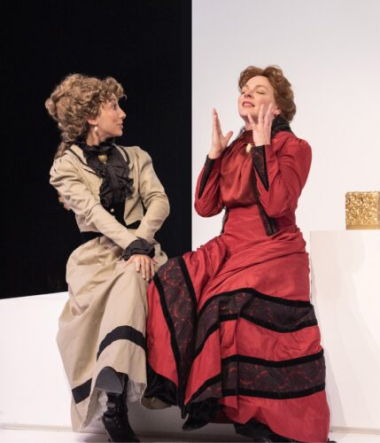
A moment of tension exists between Nora Helmer (Rachel Burttram, right) and her daughter, Emmy (Yasmine Harrell)
In Ibsen's play, Nora feels trapped in a restrictive marriage. Specifically, she eventually realizes that throughout her marriage to Torvald, he has treated her as a kind of “doll-wife.” And she has had enough. So, Nora leaves Torvald and their small children, famously slamming the door on her way out. Nora’s action was almost unheard of in 19th century Europe. Certainly, she is a feminist, and a woman well ahead of her time.
Hnath, a versatile, modern-day playwright, wondered what might have become of Nora had she been a real person. And, so, he felt inspired to write a kind of sequel to “A Doll’s House” titled “A Doll’s House, Part 2.”
What if, after leaving her smothering marriage, Nora thrived as a feminist writer championing women’s rights and denouncing marriage?
In the 90-minute, intermission-free “A Doll’s House, Part 2,” that is exactly what Nora has become. When the play begins, she returns to the home that she left, knocking on the same door that she famously slammed on her way out 15 years ago.
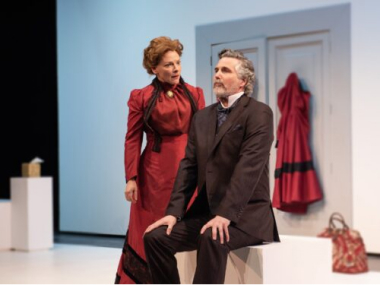
A moment of tension exists between Nora Helmer (Rachel Burttram, right) and her daughter, Emmy (Yasmine Harrell) in GableStage's production of "A Doll's House, Part 2." (Photo by Magnus Stark)
Although it may enrich your experience at “A Doll’s House, Part 2,” you do not have to be familiar with the source material to derive meaning or satisfaction from Hnath’s play. He has included enough background without overstuffing his sequel with awkward exposition.
Hnath’s smart, well-structured piece is one of the most-produced plays in American regional theaters. And it is easy to understand why. In addition to offering a most-welcome feminist message, Hnath, an Orlando-area native, writes with wry humor and keen insight.
Hnath makes actors work. For instance, he does not just give them lines of dialogue, but inserts into his script beats that serve as moments of thinking, rethinking, etc. For these beats, Hnath doesn't spoon-feed actors as to what they should do during these long periods of silence. Instead, it is up to directors and actors to determine which non-verbal methods of communication should take place during these pauses.
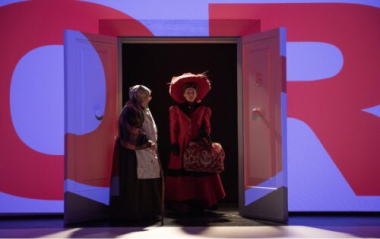
Elizabeth Dimon, left, and Rachel Burttram, in GableStage's production of "A Doll's House, Part 2." (Photo by Magnus Stark)
Director Bari Newport and the four cast members have come up with smart choices to turn Hnath’s pauses into impactful moments of live theater. In addition, Newport’s has smartly staged the play. For example, much of “A Doll’s House, Part 2” features dialogue and little other action. It would have been easy to stage the piece with little to no movement, rendering the actors little more than talking heads. But Newport creatively moves the performers around the stage, and even offstage into the audience.
Unquestionably, GableStage’s production is Brechtian. Bertolt Brecht's “Epic Theater” style forces us to pay close attention to the issues and themes that a show raises, rather than emotionally identifying too closely with the show’s action and its characters. Epic Theater’s aim is not to encourage an audience to suspend its disbelief. Instead, it forces patrons to see their world as it is. Generally, Brechtian style reminds us that we are watching a play.
By having the actors director address the audience and enter and exit from the audience seating area, Newport sets the production not just in 1894 Norway, but in modern day, reinforcing its relevance. Whether the actors are addressing the audience or each other’s characters, they deliver performances blessed with spontaneity and realism.
Rachel Burttram’s antsy, hyper, and dramatic Nora is seemingly in perpetual motion. You get the sense that what has happened to her has shaken her to the core. Also, a believable air of urgency suffuses Burttram’s Nora.
A palpable hostility exists between Burttram’s Nora and Brendan Powers’ Torvald. In addition, during friendlier moments between the two characters, Burttram and Powers demonstrate strong chemistry. In real life, the actors are spouses and both have played these roles at least once before.
Powers invests Torvald with a sense of pride that has obviously taken a hit by his wife’s actions. The actor, standing tall, makes Torvald a man trying to hang on to his dignity. He is obviously upset at seeing his wife for the first time since she left him and their children. As Torvald, Powers sometimes seethes with anger, letting it all out forcefully yet believably. But there are also times when Powers's anger is seeping below the surface.
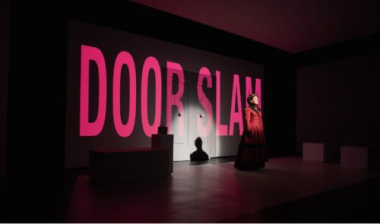
The production's Brechtian style includes projection titles.
Nora and Torvald are not the only characters in Hnath’s play. They also include Anne Marie, the Helmer family’s long-time nanny.
As Elizabeth Dimon deftly portrays Anne Marie, we keenly sense the character’s frustration after Nora has put her in an unenviable, awkward position. In addition, Dimon imbues her character with convincing weariness that comes with aging and its various challenges.
One character who does not appear in Ibsen’s play is Emmy, one of the Helmers’ offspring. She was a small child when her mother left home.
Nora meets Emmy for the first time in “A Doll’s House, Part 2. As Yasmine Harrell embodies Emmy, she comes across as a free-spirited, independent, content, and positive-thinking young lady. Clearly, she harbors no grudges against her mother.
Behind the scenes, Frank J. Oliva’s set is minimal, reinforcing the production’s Brechtian style. Also, in keeping with the style, the production includes projection titles designed by Jamie Godwin.
With the exception of a few chairs and a box of tissues, the stage is empty. Most importantly, Oliva highlights the famous door that Nora slammed in “A Doll’s House.”
Also, behind the scenes, lighting designer Tony Galaska contrasts realism from non-realism. And the lighting changes seem to happen at the same time that one of the actors snaps her fingers. It looks like magic.
Costume coordinator Camilla Haith has created striking period outfits that help define character. And sound designer Sean McGinley ensures that we can hear the performers clearly.
Certainly, “A Doll’s House, Part 2” can stand alone on its own merits. However, it is also a valuable companion piece to Ibsen’s play. In fact, theater companies may want to think about producing both plays in repertory, offering audiences a chance to see Ibsen’s play followed by Hnath’s piece.
While GableStage is not doing exactly that, the professional, nonprofit company is offering a reading of Ibsen’s original at 2 p.m. on Saturday, March 11. While tickets are free, subscribers get priority; register at www.gablestage.org. In fact, you can attend the reading of Ibsen’s play, and stay for the 8 p.m. performance of Hnath’s piece.
GableStage’s production of “A Doll’s House, Part 2” runs through Sunday, March 19 at the company’s theater next to the Biltmore Hotel, 1200 Anastasia Ave. in Coral Gables. Showtimes are at 2 and 7 p.m. Wednesday, 8 p.m. Thursday-Saturday, and 2 p.m. Sunday with an additional matinee at 2 p.m. Saturday, March 18. Streaming is also available. Tickets range from $45-$75, with streaming tickets costing $27. For more information, call (305) 445-1119 or go to www.gablestage.org.




